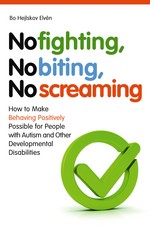Bo Hejlskov Elvén is a Clinical Neuropsychologist based in Sweden. In 2009, he was awarded the Puzzle Piece of the Year prize by the Swedish Autism Society for his lecturing and counselling on challenging behaviour.
Here, he answers some questions about his new book, No Fighting, No Biting, No Screaming: How to Make Behaving Positively Possible for People with Autism and Other Developmental Disabilities.
Can you tell us about your background, how you developed the strategies, and how the book project came about?
Since graduating with my degree in clinical neuropsychology, I worked as a child psychologist in different settings, both in municipalities and as a consultant and partner of a bigger practice in Copenhagen, Denmark. In the first years I mainly did psychological assessments, in diagnostic work and in assessments of working ability as well as in assessments concerning juveniles in corrections facilities as a base for pedagogical planning. In the former line of work I more and more often got the question: “But what can we do to manage challenging behaviour?”
In 2004, I got a part time job at the Danish Knowledge Centre for Autism as a complement to my consulting work. There, we looked at methods in working with challenging behaviour in people with autism. That work became part of the Danish National Autism Plan, in which I participated and was part of the editor’s board. At the same time the Danish authorities started worrying about restraints in special school settings, and initiated a series of conferences on the subject, where I was invited as a speaker. This resulted in people contacting me about both guidance and lecturing on the management of challenging behaviour, and from 2006 I have worked full-time doing that.
The strategies were developed in conjunction with different people. I work with the people at Studio III, with psychologist Trine Uhrskov in Denmark and with different care institutions, and we have together developed the methods and tried them out in different settings. The psychological theory is mainly my own thinking, but the philosophical basis of Low Arousal is widely spread in the world, in England mainly by Andy McDonnel.
 The book needed to be written. I did lectures every week all over Denmark and Sweden, and everywhere people asked for a book to be used in daily care work. Lectures might change the perspective for a short while, but in order to make lasting changes people need continuing guidance. So the book is not a goal in itself; it is part of a strategy to spread the Low Arousal approach in order to help people with developmental disabilities to have good lives.
The book needed to be written. I did lectures every week all over Denmark and Sweden, and everywhere people asked for a book to be used in daily care work. Lectures might change the perspective for a short while, but in order to make lasting changes people need continuing guidance. So the book is not a goal in itself; it is part of a strategy to spread the Low Arousal approach in order to help people with developmental disabilities to have good lives.
What types of ‘challenging behaviour’ do you cover in the book?
The book covers a wide range of challenging behaviours, such as aggressive behavior as kicking, hitting and biting as well as self harm, saying ‘no’, inflexibility, chewing gum in class, cursing, threats and running away. Also, the book focuses not only on the behaviours of the child with developmental disabilities, but on the actions and responses of staff and parents.
In the book you say outright that this book is about managing challenging behaviours, as opposed to changing them. Why is this an important distinction for you?
Often staff and parents have a clear goal of changing the behaviour of a service-user or child. In normal fostering that might be a good goal. In the field of developmental disabilities, though, this might not be an effective approach. Some behaviours we cannot change whatever methods we use, some challenging behaviours help the service-user or child in managing their world, and some behaviours are behaviours we might have ourselves without thinking too much about them. We might bite a nail when stressed, but consider it challenging behaviour when a child with severe difficulties bites her hand when stressed.
Then there is the issue of effectiveness. The methods aimed at changing behaviour aren’t very effective. If we focus on managing the behaviours, instead of the whole situation around the child, our service-user becomes calmer and easier. Often that means that the challenging behaviour decreases dramatically as the stress decreases. Children with developmental disabilities do no act out on purpose; I think that the service-user does her best to do the right thing, and my job is to help her succeed.
And last the issue is that of fundamental human rights. Most of the methods used in changing challenging behaviours contain a degree of force or lack of respect for the choices of the service-user. My main principle is that the service-user always has the right to say ‘no’. My job is to encourage her say ‘yes’. That means that if she says ‘no’, I need to figure out what I did wrong. In that way I actually can change her behaviour by focusing on my own behaviour, not on hers.
That said, there is one substantial chapter in the book where the focus is tilted towards change of behaviour. It is the chapter on stress. The method described is that by understanding what causes the service-user or child to be stressed, we can change the stress factors which in turn will change the behaviour. The focus is still on staff and parents, and it might take some time. The method needs to be used in conjunction with behaviour management methods, as it takes time and we need to make things work in the meantime as well.
The use of touch in discipline is a very controversial issue. How does your book address this?
Touch is a difficult issue. In my book the main view is that touch is too close in conflict situations and often increases challenging behaviour. If touch is needed in order to save somebody from harm the use of holding or restraint is not effective. I recommend using movement in a very short time, and then letting go. Even in the most dangerous of situations the situations change as soon as a member of staff touches the service-user, and moving the hand that tries to hit somebody means that you can make sure it doesn’t hit. And you can use movement without using force, just move with the service-user and correct the movement with slight pressures. After 5 seconds you can let go, and the service-user will often regain self-control as a result of your letting go. And people in self-control are not violent. Violence is a result of chaos.
Touching a service-user with a calm hand can be a way to help her relax, though. But only if it is an almost calm situation.
Most situations can be resolved without the use of touch, and every situation possible can and must be resolved without the use of force.
But mostly I don’t like the word discipline. Everybody have the right to say ‘no’, and the job of staff and parents is to make people with developmental disabilities say ‘yes’ to what we know is good for them. And when you say ‘yes’ there is no need for discipline. The word discipline implies that the service-user will not do what we want them to. Both experience and scientific evidence has taught me that everybody who can behave, does. If somebody doesn’t behave, we need to figure out why he or she can’t, then adjust our demands both in terms of what we demand, but mostly in how we demand it, so that the service-user succeeds in doing what we ask of them. In my world discipline shouldn’t ever be needed.
Can you describe a situation from your own experience in which one of the management strategies made a signifant improvement in the behaviour of a child with development disabilities?
The use of the ‘demand adjusting methods’ in my book is maybe the most effective. I often meet staff who complain about service-users who hit, spit at or kick them in demand situations. A simple method is to step backwards when you issue a demand, such as: “Put on your shoes”. I worked with a child with Asperger’s syndrome, who three to five times every day attacked staff in demand situations. When they started stepping just a couple of steps backwards as they issued the demand, and then turned and walked away the behaviour disappeared. His ability to do as they demanded increased because they didn’t stay to check on him or apply psychological pressure. The strategy to step backwards killed the challenging behaviour and has improved daily life for both the child and staff. Now, he does what they ask of him.
Can these behaviour management strategies be effectively used with adults as well as with children?
Absolutely. I work with both adults and children with developmental disabilities, and they are just as effective in both groups. The question is if they are not effective in dealing with children without developmental disabilities as well. That might be another book, though.
Copyright © Jessica Kingsley Publishers 2010.

i am so glad to learn of this book it is now at the top of my list to buy when i get paid. thanks. Linda
That sounds fabulous, especially the ‘stepping back’ from the situation. Since so many of us [or is that just me?] can be helicopter parents, that’s very valuable perspective – now if I can just put it into practice a bit more……
Best wishes and congratulations on your award.